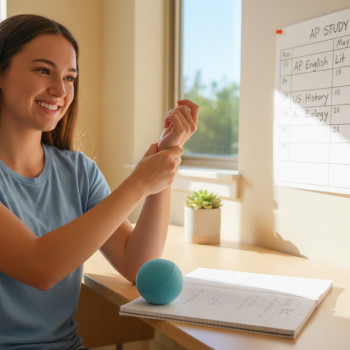Why 2D Critique Circles Matter for AP Students
If you’re in an AP Art and Design course—or preparing a portfolio for AP 2-D Art and Design—critiques are where ideas get sharper, intentions get clearer, and work grows beyond what a single artist can see alone. The classroom critique is more than a grade checkpoint; it’s a laboratory for observation, language, and revision. Done well, critique circles build confidence, teach vocabulary, and help everyone practice professional studio habits. Done poorly, they can feel vague, intimidating, or unhelpful. This post lays out practical, flexible, and student-friendly 2D critique circle formats you can use right away.
How To Use This Guide
Think of this as a toolkit. Each format below has a purpose—speed, depth, reflection, or assessment. You don’t need to use them all at once. Mix and match depending on time, class size, and what stage of work students are in. I also include scripts, sample prompts, and a table that compares when to use which format. If you’re using tutoring support—say Sparkl’s personalized tutoring—these formats are great to practice in one-on-one sessions before presenting in class. Tutors can role-play peers and help you rehearse responses, tighten language, and calibrate critique to rubric criteria.
Core Principles for Respectful, Useful Critiques
- Start with intent: Have each artist state their goals for the piece in one sentence.
- Be curious, not judgmental: Ask questions to understand choices before suggesting changes.
- Use specific language: Point to formal elements (line, color, composition) and principles (contrast, rhythm, balance).
- Balance praise and improvement: Aim for at least one strength, one question, one suggestion.
- Timebox comments: Keep rounds short for focus—3–5 minutes per speaker is often enough.
- Follow rubrics when available: If you’re preparing for AP scoring, anchor feedback to the rubrics or portfolio standards.

Format 1 — The Rapid Round (Best for Frequent, Low-Stakes Feedback)
Use when you want many students to receive feedback quickly—ideal for weekly check-ins or warm-up days. Keep momentum high and responses focused.
How it works
- Arrange students in small circles of 4–6.
- Each artist has 60–90 seconds to state intent and one challenge.
- Each peer has 45–60 seconds to give: 1 Strength, 1 Question, 1 Suggestion.
- Teacher or facilitator gently enforces time and models concise language.
Why it works
Rapid Round trains students to identify the most vital feedback quickly and keeps critique anxiety low. It’s also easy to replicate in one-on-one tutoring sessions with Sparkl’s personalized tutors who can simulate multiple peers and help students practice concise phrasing.
Format 2 — The Deep Dive (Best for Portfolio Pieces)
Reserve this format for work heading into an AP submission or major critique. It’s slower, more reflective, and allows for probing the conceptual layers of a piece.
How it works
- Set aside 20–30 minutes per artist (or split across two class periods).
- Artist presents 2–3 goals and any constraints they’re working with.
- Peers respond in rounds: Observations (3 minutes), Interpretation (3 minutes), Suggestions/Strategies (4 minutes).
- End with the artist restating what they’ll revise next and a timeline for follow-up.
Practical tips
- Provide sticky notes for peers to write specific suggestions—concrete enough to return to later.
- Encourage peers to reference specific parts of the work (“top left corner,” “secondary color palette”) to avoid vagueness.
- Record the session (audio or teacher notes) if the artist wants to review feedback later.
Format 3 — The Rotate-and-Respond Gallery (Best for Large Classes)
A gallery walk brings movement into critique and allows students to see many works in one class. Pair it with written responses to keep feedback balanced.
How it works
- Pin artworks around the room with a feedback sheet beside each piece.
- Students rotate in small groups, spending 4–6 minutes at each work to leave 3 types of notes: What I Notice, What I Wonder, One Suggestion.
- After the walk, artists read comments and select 3 notes they find most helpful to discuss in a short reflection.
Format 4 — The Socratic Circle (Best for Conceptual Analysis)
When ideas and narrative are central to a piece, a Socratic Circle encourages in-depth questioning and evidence-based interpretation.
How it works
- Place the presenting artist in the center or as an observer while peers form an inner and outer circle.
- Inner circle discusses interpretation; outer circle listens and records questions or counterpoints.
- Rotate roles so everyone practices both questioning and listening.
Benefits
This format builds verbal articulation and helps students defend choices with visual evidence—skills AP readers value in portfolio narratives and score rationales.
Format 5 — The Criteria-Driven Critique (Rubric-Focused)
Use this when preparing for AP scoring. Align peer feedback with specific scoring criteria so revisions target what reviewers score.
How it works
- Share a simplified rubric with 3–5 criteria (e.g., Evidence of Process, Quality of Work, Synthesis of Ideas).
- Peers score each criterion with a brief justification and one action to improve that criterion.
- Artist makes a brief plan linking each action to a timeline.
Sample simplified rubric table
| Criterion | What to Look For | Peer Score (1–5) | Suggested Action |
|---|---|---|---|
| Evidence of Process | Sketches, iterations, artist notes | 4 | Add two more thumbnails showing alternative compositions |
| Quality of Work | Craft, control of media, resolution | 3 | Refine edges and increase contrast in focal area |
| Synthesis of Ideas | Original connection between concept and solution | 5 | Write a short artist statement highlighting the unique link |
Format 6 — The Compliment Sandwich (Best for Beginners)
Simple, scaffolded, and reassuring for students new to critique. It keeps comments constructive and concrete.
How it works
- Each peer speaks in three parts: Genuine Compliment, Specific Observation, Actionable Suggestion.
- Encourage “I” statements: “I notice,” “I’m curious about,” “I suggest.”
- Keep each part to one sentence to avoid rambling.
Scripts and Sentence Starters to Keep Things Productive
Many students freeze because they can’t find words. Give them sentence starters. Practice these aloud before the first few critiques so language becomes second nature.
- Intent: “My goal was to…”
- Observation: “I notice that the composition places emphasis on…”
- Interpretation: “This makes me think of…”
- Question: “What led you to choose this color palette?”
- Suggestion: “Have you considered…”
- Reflection (artist): “I heard X; I plan to… by next class.”
Managing Time and Emotional Energy
Critiques are emotionally charged. Here are practical class management strategies:
- Set a clear time structure and stick to it—use timers visible to the whole room.
- Offer opt-out roles for students who are anxious: they can write feedback instead of speaking.
- Teach and model active listening—no interruptions, no dismissive gestures.
- Normalize revision: emphasize that feedback doesn’t mean failure; it means refinement.
Using Technology to Augment Critiques
While in-person critique is irreplaceable, tech can extend the conversation. Try photo documentation, short video explanations, or a shared digital board where peers leave time-stamped comments. If you’re working with a personal tutor from Sparkl, they can help edit recorded explanations, suggest concise language, and provide AI-driven insights to highlight recurring patterns in feedback.
Sample Weekly Critique Plan for a 6-Week Unit
Below is a sample schedule that balances rapid checks, deep dives, and rubric alignment as pieces move toward a portfolio submission.
| Week | Focus | Critique Format | Outcome |
|---|---|---|---|
| 1 | Idea generation | Rapid Round | Selection of concepts to develop |
| 2 | Thumbnails and comps | Rotate-and-Respond Gallery | Prioritized compositions |
| 3 | First refined draft | Deep Dive | Targeted revisions list |
| 4 | Integration of process work | Criteria-Driven Critique | Rubric-aligned improvements |
| 5 | Final adjustments | Compliment Sandwich + Peer Edits | Polished pieces and written reflections |
| 6 | Portfolio review | Socratic Circle + Artist Statements | Portfolio-ready works and statements |
Assessing the Quality of Peer Feedback
Not all feedback helps learning. Use simple metrics to evaluate critiques so students get better at giving them:
- Specificity: Does the comment point to a visible element or give an example?
- Usefulness: Can the artist act on the suggestion in one class period?
- Connectedness: Does the feedback connect to the artist’s stated intent?
- Respect: Is the tone constructive and encouraging?
How Tutors and One-on-One Practice Improve Critique Skills
Critique fluency grows with rehearsal. Working with a tutor—such as those offered through Sparkl—lets a student practice articulating intent, answering probing questions, and synthesizing feedback before presenting to peers. Tutors can also give targeted exercises: phrasing practice, timed responses, and rubric alignment drills. Over time, students who rehearse in private present stronger, clearer work and lead more productive peer sessions.
Common Pitfalls and How to Avoid Them
- Digital Overload: Too many written comments without conversation can feel impersonal. Pair written notes with a brief verbal follow-up.
- Personal Critiques: Keep feedback about the work, not the person. Replace “You failed to…” with “The composition currently lacks…”
- Vague Advice: Avoid “Make it pop.” Instead, say, “Increase contrast in the focal area by darkening the background or brightening the highlight.”
- Dominant Voices: Rotate speaking order and use timers so a few students don’t monopolize the critique.
Real-World Example: From Critique to Revision
Imagine Maya, an AP 2-D student whose mixed-media collage felt conceptually strong but visually muddy. In a Deep Dive, peers pointed out that her focal area competed with an overly textured background. Using Criteria-Driven feedback, Maya scored “Quality of Work” lower and set a revision goal: simplify background texture and increase contrast at the focal point. She practiced the language for her artist statement with a Sparkl tutor, who helped her condense process notes into a clear two-sentence rationale. The revised piece read stronger, and Maya linked the changes directly to the rubric—an improvement both visually and in how she presented the work.

Checklist: Running a Successful 2D Critique Circle
- Define intent at the start of each critique.
- Choose a format that matches time and stakes.
- Supply sentence starters and a simplified rubric when preparing for AP review.
- Use timers and roles to maintain fairness and focus.
- Encourage written follow-ups for students who prefer reflection time.
- Practice with tutors or mentors to rehearse language and refine presentation.
Final Thoughts: Critique as Creative Conversation
Critiques are not a report card in front of your peers—they’re a conversation where ideas get tested and art becomes more intentional. The best critique circles are repeatable, scaffolded, and teach students how to listen and respond with clarity. Whether you’re rehearsing with a tutor, trying a quick Rapid Round, or scheduling a Deep Dive before portfolio submissions, these formats will help you and your classmates grow as makers and thinkers.
One last piece of encouragement: feedback is a tool, not a verdict. Keep the conversation focused on choices and outcomes, and use each critique as an opportunity to refine both your work and your voice as an artist. If you want targeted practice, consider pairing these formats with personalized tutoring sessions—expert guidance can make your critiques more effective and your revisions more purposeful.
Try this next class
- Pick one format from this guide and run a 30-minute session.
- Rotate roles so everyone practices both giving and receiving feedback.
- Have each artist leave with one specific action and a timeline for revision.
Happy critiquing—may your circles be curious, kind, and creatively electric.




















No Comments
Leave a comment Cancel